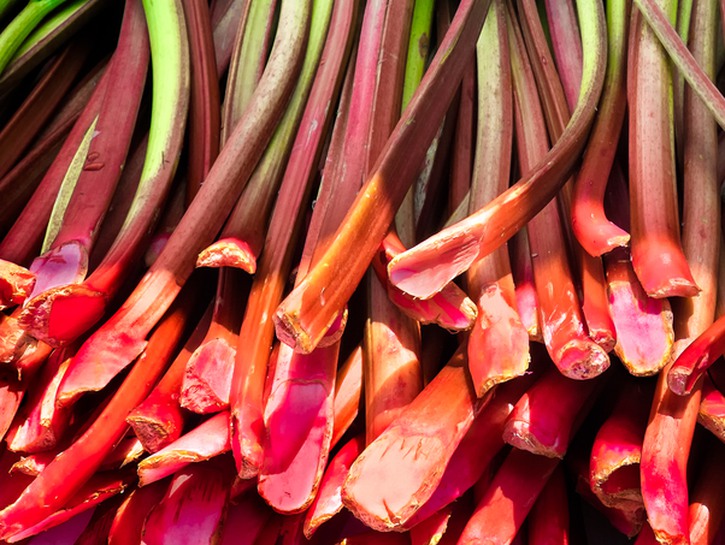What Is Rhubarb?
You probably know rhubarb as that tart ingredient that goes in pie sometimes, but beyond that it’s still a mystery. So what exactly is rhubarb and why do we use it?
Rhubarb is an herbaceous perennial that grows in thick stalks that kind of look like pink celery. Rhubarb also has large green leaves at the stalk that cannot be consumed because they contain high levels of oxalic acid, which makes them toxic. The plant was first used as an herbal medicine in China thousands of years ago because it was believed to stop the growth of dysentery.
Though rhubarb can be eaten raw, it’s most commonly cooked with sugar to offset its naturally bitter and tart taste. People didn’t start adding rhubarb to desserts and pies until the 18th century when sugar became more accessible across England. Today, rhubarb is most commonly used for baked goods, jams, and jellies and is often paired with strawberries to help ease rhubarb’s bitterness.
Is Rhubarb A Vegetable Or A Fruit?
The distinction of whether or not rhubarb is a fruit or vegetable is a confusing one. A whole rhubarb stalk looks just like a pink celery stalk, yet it’s often associated with fruit pies. Botanically, rhubarb is a vegetable. However, rhubarb is legally a fruit in the United States. Back in the 1940s, rhubarb was usually prepared as a fruit and by legally declaring it as such, many businesses who imported rhubarb saved a lot of money on taxes.

Growing Rhubarb
Growing rhubarb is actually pretty easy. Since they are perennials, they will come back for a few seasons once you plant them. Rhubarb is best grown in cool locations that get lots of sunlight. If you do live in a warmer climate, give your rhubarb plant a little shade for long and thin stalks.
Instead of planting your rhubarb from a seed, try growing them from root divisions called crowns. Once your plants start to sprout, spread mulch around the base of the stalks to ensure moisture retention in the soil and keep weeds from growing. When foliage dies in the fall, renew the mulch to protect the roots so they can come back in the spring.
Generally you can harvest 2 to 6 pounds of rhubarb from one plant in a single season. Rhubarb thrives in cool, moist weather, while warm and dry weather may inhibit production. Your rhubarb will be ready to pick once the leaves are fully grown. To pick your rhubarb, just twist them at the base and pull. You can also cut them with a knife (just be careful). Make sure you cut off the leaves while you’re harvesting and add it to your compost.
Rhubarb usually doesn’t have problems with pests, however it can sometimes get ambushed by pests like rhubarb curculio, European corn borers and cabbage worms. Though it is rare, rhubarb can also get diseased with Verticillium wilt, which can make the plant prematurely wilt. If you see diseased plants, remove them and replant with healthy ones.

How To Use Rhubarb
Because rhubarb is so tart, we don’t recommend eating it raw (unless you are very brave). Luckily, there are plenty of ways to prepare rhubarb. Stewing is probably the easiest and most common method of preparing rhubarb, but you can also roast, sauté, and puree it. Stewed rhubarb is great in pies, cakes, over ice cream, and even in cocktails. However you decide to prepare rhubarb, just make sure to remove the toxic leaves!
Rhubarb Recipes
Want to try your hand at cooking and baking with rhubarb? Check out these recipes!
